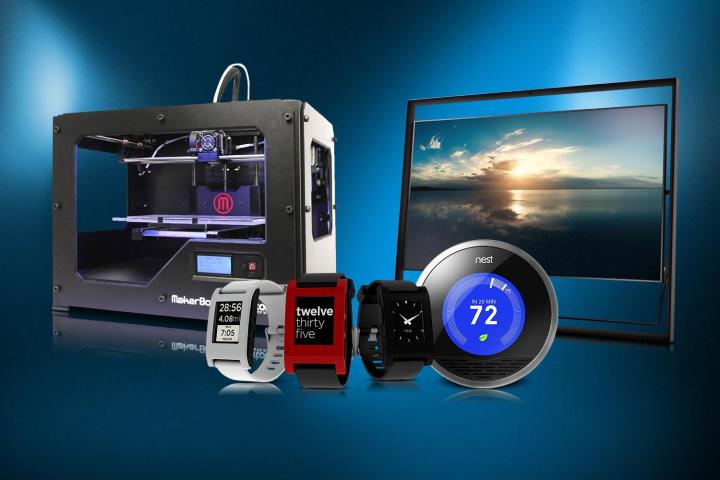
By the time you read this sentence, thousands of technology companies, analysts, and journalists from around the world will be descending upon Las Vegas for the 2014 Consumer Electronics Show, which will consume most of the week to come. Intense, grotesque, engulfing, and utterly unlike any other trade show in consumer technology, CES provides the world its first glance at what’s to come during the 12 months ahead and beyond.
CES 2014 promises its share of big product reveals. But more important than that, it gives us a look at the industry as a whole, a chance to see whether the fleet that make the various categories of gadgets, sensors, systems, and gizmos is headed in the right direction or off into Lala Land. Here are the five big questions I hope to have answered at CES 2014.
Will wearable tech be something people want to wear?
The elephant in the room, wearable tech is set to dominate CES 2014. Smartwatches, fitness bands, smartglasses, and even pet health and activity trackers are waiting on deck, ready to grab a piece of the estimated $19 billion we’re expected to spend on wearable gadgets over the next four years.

Pebble has a head start in the smartwatch niche, and we expect some big announcements from the company at this year’s CES. Also keep an eye out for Sony, Archos, and China’s ZTE.
Will 4K break out of its luxury niche?
Call it 4K, call it Ultra HD, call it whatever you like – the next generation of high-definition video will steal its share of the spotlight at CES 2014. Problem? This super-resolution technology – we’re talking four times the resolution of 1080p displays – remains both expensive and far less useful than standard HD devices. For example, Samsung’s 110-inch Ultra HD TV, which debuted at CES 2013, costs as much as a house. And so far, there is relatively little content available at a 4K resolution … meaning there’s no need to plunk down $150,000 on a first-generation Ultra HD television unless you want to show off your bank account.

Word on the street is that 4K television shipments are set to jump from the 1.9 million units sold in 2013 to more than 12 million this year. We’ll look to see if the prices and content ecosystems are there to support that speculation.
Does 3D printing have what it takes to go mainstream?
This won’t be the first year 3D printing companies made themselves known at CES. But it will be the first year that this burgeoning DIY industry takes the show by storm. According to Gary Shapiro, President and CEO of the Consumer Electronics Association (the trade group that puts on CES), we should expect a flood of 3D printing companies at CES 2014. The category even has its own area on the show floor, the 3D Printing TechZone.

All of this sounds awesome, and I couldn’t be more excited to see what 3D printing has to offer. Still, we have yet to see this so-called revolutionary technology take off among everyday consumers. But something tells us 2014 will be a big year for this category – and we’ll get the best sense of whether our gut reaction is right in on the show floor at CES.
Can the dream of a connected home become a reality?
Since the 1960s, Americans have dreamed of a home that handles all the arduous chores of life for us – or at least makes them a bit easier through technology. And for years, CES attendees have told us that the “connected home” (one piece of the so-called Internet of Things – microwaves, dishwashers, thermostats, and anything else that can be outfitted with an Internet connection) will take over modern life … any day now.

But the dream of a connected home isn’t just about new products – it’s about creating technological standards that will allow all of these Internet-connected devices to talk to one another and to us. A group calling itself AllSeen Alliance is trying to do just that, and we’ll be looking to see whether its influence is enough to bring the connected home future out of the realm of 60s science fiction.
Can CES remain the center of the consumer tech universe?
This question has popped up during every CES for the past few years. Thanks to a growing number of big brands holding their own Apple-style press conferences to unveil flagship products throughout the year, and the ease of sending out a buzzy press blast via blogs and PR emails, many companies have decided in the recent past to simply use CES as a place to showcase already unveiled products.
What this means, effectively, is that enthusiasm for CES has waned. We – meaning those of us in the tech press who make the trek to Las Vegas each year for the sole purpose of reporting on the next big things – want to be blown away. We want to tell you about all the amazing things 21st century consumer technology has to offer.
Something in my gut tells me this year will be different. The Big Boys of tech – Samsung, LG, Google, Apple, Sony, etc – may choose to save the best for their own shindigs. But a new batch of technology companies, smaller brands like Pebble and MakerBot, have begun to fill in the gap. The tech they are creating is something new. And that adds a cup of gas to the fire.
If I had to make one prediction for CES 2014, I’d say this is the year we start to get excited about our yearly journey to the desert once again.


